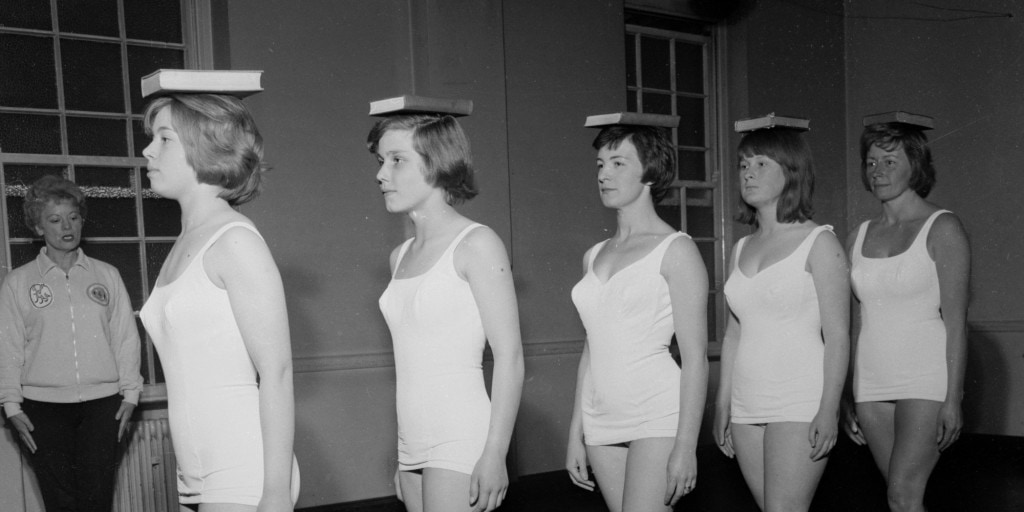In her recently published book “Slouch: Posture Panic in Modern America” Beth Linker argues that at the onset of the twentieth century the United States became gripped by a poor-posture epidemic: a widespread social contagion of slumping that could have deleterious effects upon individual health, and the body politic.
Posture science began in the latter half of the nineteenth century, when archeologists and natural scientists were theorizing about the evolutionary relationship between Homo sapiens and other primates. Which came first: upright walking or higher cognition? The dominant view was that the evolution of the human brain preceded the development of bipedalism, leading some to wonder whether problems, like flat feet or scoliosis, were, in effect, the price of braininess.
Before long, there was a societal investment in the betterment of health through the improvement of posture. Among the most significant popularizers of posture science was Jessie Bancroft, who helped found the American Posture League in 1914. She introduced a standardized posture test that could be easily carried out by a teacher equipped with little more than a pole against which a student’s carriage might be compared. Students who failed the assessment—as much as 60% of the public-school population—could be assigned corrective exercises.
Anxieties about posture inevitably collided with anxieties about class and race. Slouching was associated with poverty and with manual, industrialised labor—such as the working-class immigrants from European countries who, in their physical debasement, were positioned well below the white Anglo-Saxon Protestant establishment. Linker argues that, in this environment,
posture served as a marker of social status similar to skin colour.
At the same time, populations that had been colonised and enslaved were held up as posture paradigms for the élite to emulate: the American Posture League rewarded successful students with congratulatory pins that featured an image of an extremely upright native-American Lenape man. The head-carrying customs associated with African women were also adopted as training exercises for white girls of privilege, although Bancroft and her peers recommended that young ladies learn to balance books not baskets; markers of their own access to leisure and education.
This being America, posture panic was swiftly commercialised, with a range of products marketed to appeal to the eighty per cent of the population whose carriage had been deemed inadequate by posture surveys. The footwear industry drafted orthopaedic surgeons to consult on the design of shoes that would lessen foot and back pain without the stigma of corrective footwear. The indefatigable Jessie Bancroft endorsed a company that created a “Right-Posture” jacket, whose trim cut across the upper shoulders gave its schoolboy wearer little choice but to retract his shoulders. Bancroft’s American Posture League also endorsed girdles and corsets for women; similar garments were also adopted by men, who, by the early nineteen-fifties, were purchasing abdominal “bracers” by the millions.
It was in this era that what eventually proved to be the most contentious form of posture policing reached its height, when students entering college were required to submit to mandatory posture examinations, including the taking of nude or semi-nude photographs. For decades, incoming students were evaluated for conditions such as scoliosis by means of a medical exam, which came to incorporate photography to create a visual record. The practice was gradually abandoned by colleges, thanks in part to the rise of the women’s movement, which gave coeds a new language with which to express their discomfort.
Research carried out in the 1970s by Gretchen Dieck, then a doctoral student at Yale, set out to use postural images taken at Smith College, cross-referenced with present-day self-reports by alumnae, to see whether the presence of spinal curvature in a teenage girl predicted back pain in later life. Contrary to the decades-long drumbeat of the posture-correction establishment, a diagnosis of poor posture in youth didn’t correlate strongly with future back pain; even scoliosis, which at the time was aggressively treated with metal braces, and sometimes with implanted steel-rod, played a “relatively unimportant role in the development of spinal pain in the adult years.” The findings brought into question all the allegedly predictive surveillance of posture, not to mention all the devices and treatments sold to Americans with the promise of averting future pain.
Linker reports, paleoanthropologists have begun to revise the popular idea that our ancient ancestors did not get aches and pains in their backs. Analysis of fossilised spines has revealed degenerative changes suggesting that “the first upright hominids to roam the earth likely experienced back pain, or would have been predisposed to such a condition if they had lived long enough.” Slouching, far from being a disease of civilisation, then, seems to be something we’ve been prone to for as long as we have stood on our own two feet.
References
Mead R. (2024). The truth behind the slouching epidemic. The New Yorker, April 15, Accessed online at https://www.newyorker.com/magazine/2024/04/15/slouch-posture-panic-in-modern-america-beth-linker-book-review

